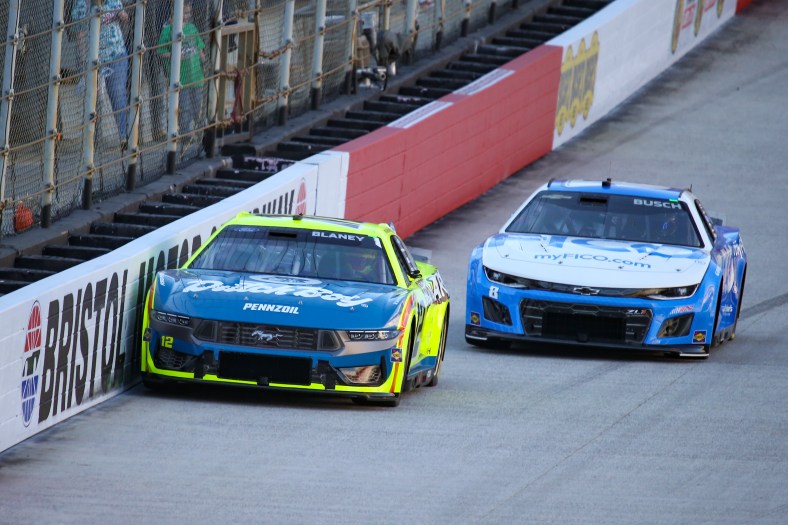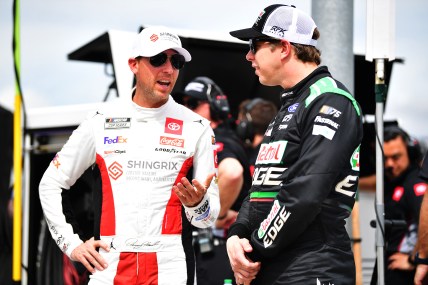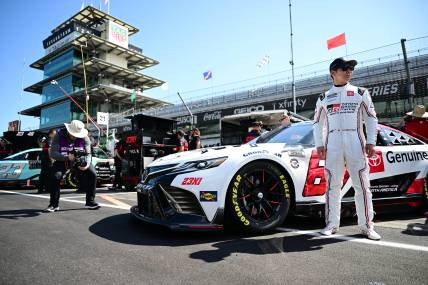
The NASCAR Cup Series is back to racing on concrete at Bristol Motor Speedway but drivers were not greeted by the same surface they left back in September.
The PJ1 traction compound applied in the corners since the 2016 Bristol Night Race has now been replaced by a resin and it would be an understatement to suggest that made things really complicated for all involved on Saturday.
Several drivers broke traction during time trials and it came down to having a completely different level of grip from what they experienced in practice just 30-45 minutes beforehand … and probably six months ago too.
Chris Buescher was one of those drivers.
“I landed in the corner and just got really loose,” Buescher said. “I got up in all the marbles before the second lap so it was all but useless.”
The resin just doesn’t have the longevity, it seems, like the PJ1 had.
“It’s certainly different and there’s not much left at this point,” he said after qualifying. “I’m sitting here right now wishing we had PJ1 but I just got in the corner, got free and ended up in a ton of marbles up there.”
The marbles are another variable, but more on that later.
“The first group got three quarters of the way through (qualifying) and it was like a light bulb got switched and the track lost several tenths of a second,” Buescher said. “We just tanked and the balance changed significantly on the bottom.
“Right now, I’m thinking the bottom won’t be of much use once we get the track swept and the top clean up, we’re all going to move up.”
Martin Truex Jr. said it was like no one had any idea what was going on as the track just changed in ways that no one was prepared for. There is a new traction compound and a new tire compound and also the first day race at Bristol with the NextGen car.
“Each race here has been a little different, the tire and temperature, a lot of variables to know what is going to happen but we definitely have no idea what is going to happen tomorrow,” Truex said. “We completely wore our right sides out in practice and we didn’t even run that many laps. There’s definitely some stuff going on here that we’re not used to.”
Truex said engineers are going to be ‘smoking’ their computers overnight trying to figure it out.
Another complicating factor is that NASCAR may or may not apply another spray of the resin overnight after the Truck Series race, depending on if they think enough is there for the start.
William Byron isn’t sure if they should but agreed that it will be eventually a race to the top.
“I ran a 15.7 in qualifying (on the bottom) and we’re running 16.0s or 16.2s up top so it was close to coming in,” Byron said.
“It wasn’t the most fun thing but once you realize everyone is running that speed, you accept there isn’t more grip to find. It was definitely a lot different than we were expecting. It’s a unique challenge because usually the bottom has grip throughout practice and we’re left wondering what we need to run the top, but we got forced up there sooner, so now we know early, I guess.”
But this is where things get tricky.
Let’s say NASCAR does apply another layer of resin to the bottom, if they feel like the trucks peeled it up, and they want it there for the start of the 500 lap Cup Series race. The race will start on the bottom, with the tires kicking rubber marbles up the track, making it really treacherous for whoever goes up there first.
Driving over the marbles also contributes to a car breaking traction, so pole winner Ryan Blaney doesn’t expect to be the first to move up there, instead leaving it to someone like Kyle Larson or Tyler Reddick. It also helps that Blaney will have the track position to allow him to be a little more patient.
“I’m not doing it just because you never know how dirty it is and with these marbles that we see putting down you never know how much it’s going to get pushed up,” Blaney said. “You can’t just jump right to the top. You have to continuously work it up and up.
“That works by moving up three feet and then moving it up another three feet and then moving it up another three feet until you’re at the wall and all that crap is cleared off the racetrack.”
Michael McDowell compared it to a dirt race and brushing off the cushion.
“If you get too high, too early, you bite the dust,” McDowell said. “We won’t know until we know. But once you get guys racing side-by-side, the marbles kind of take care of themselves.”
Denny Hamlin won the Night Race last year by running the bottom even after the PJ1 had largely been peeled up but Byron doesn’t think the bottom will be there tomorrow with the resin.
“The bottom is not going to be super effective if it’s like this,” Byron said. “On restarts, new tires, there might be some pace down there. On equal tires, late in the run, there probably won’t be any pace down there.”
But like everyone else, McDowell is puzzled why the surface was so different than expectations.
“I’m just really curious, and want to know, why is it so different,” McDowell said. “Is it the tire, or resin versus PJ1 and a tire dragon, but it was so different today. It surprised all of us, I think.”
Matt Weaver is a Motorsports Insider for Sportsnaut. Follow him on Twitter.

